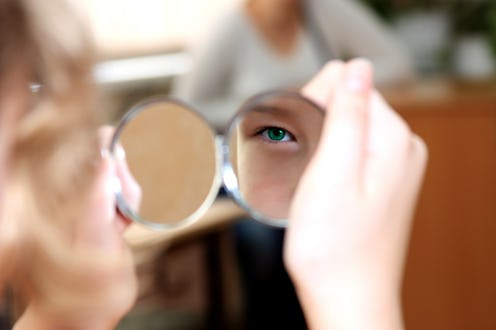Style
5 Things You Might Not Know About Milia

When bumps pop up on your skin, it's natural to be a little nervous. Trying new beauty products can lead to skin reactions, which are usually relatively harmless. But you've probably stumbled upon some little dots near your nose and wondered, "What are the skin colored bumps under my eyes?" One of the most common skin problems known to man is called milia, and yes, they are the little white or flesh-colored dots that appear on your skin, usually under your eyes. “Milia, or keratin ‘pearls’ are tiny collections of keratin under the skin,” dermatologist Dr. Deanne Mraz Robinson, MD, FAAD explains.
Luckily milia are common, painless, and “totally harmless, just cosmetically annoying,” dermatologist Dr. Jessica Krant, MD, MPH tells Bustle. The most typical place for them to pop up is on the face, usually on the skin around your eyes or on your cheeks. However, they can appear pretty much anywhere, and “can come in any age group at really any time,” dermatologist Dr. Dhaval G. Bhanusali, MD, says. “They are commonly seen in babies but we also see milia in the office almost daily.” Left untreated, milia may go away on their own, but they don’t always. As with all skin concerns, it’s best to see a board-certified dermatologist to get a proper diagnosis and treatment plan, if treatment is necessary. To hold you over until that appointment, here are five things you may not already know about milia.
1. Milia are not acne.
Yes, they’re similarly annoying bumps, but milia are not a form of acne. “Milia, or milium cysts, are very tiny true cysts made up of a sac or shell of outer layer skin cells known as keratinocytes,” Krant explains. “They sit immediately under the top layer of skin and show as small, hard, white bumps … Milia are not the same as pimples or whiteheads. For this reason, most aestheticians, upon encountering true milia, will refer to a board-certified dermatologist for removal.” Again, there’s no medical need to remove them, but if they’re bothering you for an aesthetic reason, a dermatologist can help you out.
2. Your beauty routine could be to blame.
Krant, Mraz Robinson, and Bhanusali all mention that certain skin care products could trigger milia. Specifically, Mraz Robinson says “very occlusive, oily, or heavy skin care products” could be the culprit. Bhanusali also notes, “We commonly see it in our entertainment crowd due to production makeup being so heavy and a lack of cleansing after.”
3. But derms aren’t always sure what causes them.
In addition to heavy skin care products, Krant notes that milia can form after a skin injury. “But sometimes they form and dermatologists don’t really know why,” she says. In addition, Krant says that we don’t yet know if genetics can play a role in your likelihood of developing milia, although Bhanusali notes they are very rarely associated with Rombo syndrome and Gardner syndrome.
4. You shouldn’t try to remove them at home.
Since heavier products could trigger milia, switching up your skin care routine might help slowly reduce the number of milia that form on your face. “I usually tell my patients to try a gentle alpha (glycolic) or beta (salicylic) acid cleanser for a week or two. Sometimes, if the milia are very superficial, it can push the debris out,” Bhanusali says. However, you should never try to remove the individual milia at home. “True milia can not be removed at home. Trying to remove them with a comedone extractor at home will cause injury and possibly scarring and infection,” Krant explains. “Removing them requires a small surgical procedure that even aestheticians are not allowed to perform because it requires truly going beneath the skin surface.” Since removing them does require breaking the skin surface, Mraz Robinson notes the process “can carry the risk of infection or damage to the skin” if not done in a dermatologist’s office.
5. Removal by your doctor is not usually covered by insurance.
Since there is no medical reason to get rid of milia, you’ll likely have to pay out of pocket if you want them removed. “Dermatologists can help remove any milia, but keep in mind this procedure is considered cosmetic by insurance companies, and is therefore generally not covered by insurance,” Krant explains. Since they're totally normal and have no medical risk, it might be easier to just work on embracing those little bumps instead.
This post was originally published June 19, 2015. It was updated July 8, 2019.
This article was originally published on